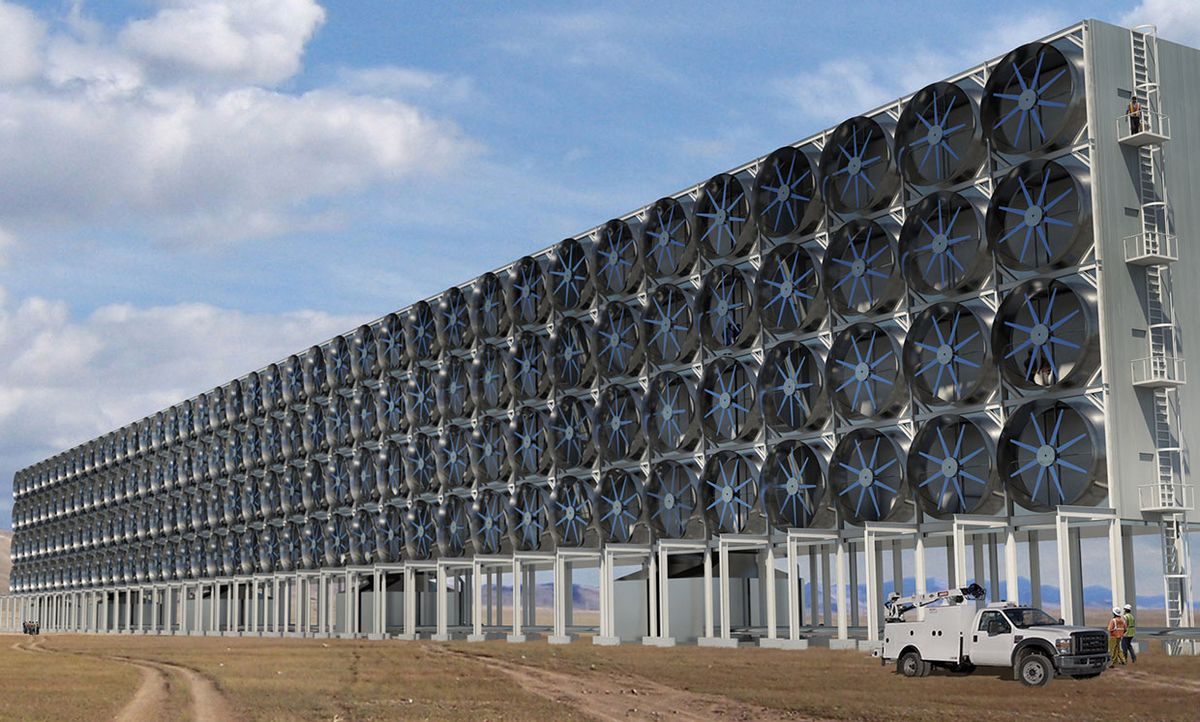In the fight to slow down climate change, few ideas generate more hype, scorn, and desperate hope than capturing carbon dioxide from the air. Critics point to its massive expense, as much as US $1000 to extract a metric ton of carbon dioxide.
Now Harvard geoengineer David Keith has proven that direct air capture is doable on an industrial scale for $100 a ton.
Carbon Engineering, the company Keith founded in 2009 and that has Bill Gates’ support, has been capturing a ton of carbon dioxide every day since 2015 at its pilot plant north of Vancouver. Keith and his team have now come up with the first-ever detailed engineering design and cost analysis of a plant that would capture 1 million tons of carbon dioxide a year. They describe their results today in the journal Joule.

“There has been a lot of talk about direct air capture technology,” Keith says. “We help to bring it down to reality. This is not some kind of narrow scientific innovation. It’s not something we did in the lab. It’s the product of a tested engineering process.”
Carbon Engineering uses a bank of giant fans to draw ambient air and push it through an aqueous solution that reacts with carbon dioxide. Heat and known chemical reactions separate the CO2 molecules. The company combines it with hydrogen produced from water electrolysis to create liquid fuels that can be used in today’s trucks and aircraft engines. They started making these fuels at the plant in December.
Keith acknowledges that making carbon dioxide an ingredient in fuel doesn’t help to reduce the overall amount of carbon dioxide in the atmosphere. But because the carbon-neutral fuel replaces fossil fuels that would add more planet-warming gas to the atmosphere, it would make a large dent in transportation-related CO2 emissions.
While the technology to capture carbon dioxide from air isn’t new—it was first developed in the 1950s—its use on a large scale to prevent global warming is so far unproven and unaffordable. Estimates of the technology’s cost have ranged from $50 to $1,000 per ton of carbon dioxide. But Keith and his colleagues’ number-crunching fills a vital void. “Those others were estimates made from scaling,” he says. “Our number comes from a deep effort to do the full engineering.”
In their paper, the researchers describe every step of the direct air capture process, with an energy and mass balance. They also identify a commercial hardware vendor for each unit or commercial hardware that can be adapted to perform the process. Finally, they calculate a range of costs by taking into account energy use—the design relies on natural gas and electricity—and capital expenses for systems that use different chemicals, materials, and equipment designs. They calculate a levelized cost of $94 to $232 for capturing a ton of carbon dioxide.

The team is now trying to finance its first commercial plant, Keith says. It will use the cheapest low-carbon energy available, be that wind or solar. This should help cut energy use and bring down costs. The fuel the plant produces will likely still cost more per gallon than fuel you can buy at your local refueling station. But even if they can bring it down to $1.05 per liter ($4/gallon), it could be economically feasible when used in vehicles that meet California’s low-carbon fuel standards.
Swiss company Climeworks has already built a commercial carbon dioxide–capture plant. The facility near Zurich, which began operation last year, uses fans to draw ambient air through filters that trap carbon dioxide. The 900 metric tons of carbon dioxide that it can trap every year are sent to greenhouses to grow plants.
“The difference is really of scale,” Keith says. Climeworks’ units are smaller and their process is simpler. But they would need a large number of units for industrial scale. “So if you want to capture on small scale, theirs beats us,” he says. “But if you want industrial scale capture where you’re making 2000 barrels of fuel a day, we can get cost number down to $100/ton.”
Critics say that direct air capture is a distraction. The focus should be on keeping carbon dioxide out of the air by capturing it at power plants or using clean energy sources. But the reality is that the world will continue to burn fossil fuels for decades. Many scientists agree that we need to use all the tools we have to fight climate change. If Carbon Engineering can get carbon dioxide out of the air in a relatively cheap way, more power to them.
Prachi Patel is a freelance journalist based in Pittsburgh. She writes about energy, biotechnology, materials science, nanotechnology, and computing.



